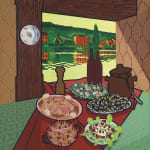Patrick Caulfield 1936-2005
152.4 x 152.4 cm
Pushing this formal experimentation further, in Still Life: Maroochydore the artist incorporates a wide range of jarring painting styles which compete with one another for the viewer’s attention. The crimson tablecloth and a number of the objects upon it are uniformly painted and bound by bold, black lines, pointing towards a hard, graphic style inspired by Juan Gris. The window frame is characterized by a distinctive flattened wood-grain effect, while in contrast, the china plate and the screw of the peppercorn mill are rendered in exquisite detail. The landscape beyond the window, meanwhile, is captured in emotive brushstrokes, imbuing the top half of the composition with a romantic softness.
Caulfield’s decision to combine multiple visual languages within his paintings is rooted both in the way he viewed the world around him and how he recalled those experiences, as he explains:
‘I find that in treating different things in different ways, they become a point of focus. It’s the idea that one doesn’t encompass everything, and that your eye can look around and see things. I’m not sure whether it’s your eye or whether it’s that your memory remembers things in different ways. There seems no reason to treat everything evenly. It’s more like a collaged memory of things. Some of the things are in sharp focus, and others, if you like, symbolise the object.’ 1
To create this imagined scene Caulfield drew inspiration from a variety of sources. The view beyond the window is derived from a black and white carte postale, depicting a river-side view of Thoméry-sur-Seine in France, while the colour scheme of cadmium orange, yellow and emerald green is inspired by another postcard of the Australian town of Maroochydore and the dishes of choucroute garnie, escargots, seafood paella, and salade niçoise on the table are from traditional French photographic recipe cards. This amalgamation of exotic images, from places real and imagined, reinforces the enigmatic, dream-like quality of the painting.
1 The artist, quoted in Marco Livingstone, Patrick Caulfield, Lund Humphries, Aldershot, 2005, p95
Provenance
The Artist
Leslie Waddington Collection, acquired directly from the above
Private Collection, London
Exhibitions
Liverpool, Walker Art Gallery, Patrick Caulfield: Paintings 1963-81, 22 August - 4 October 1981, cat no. 48, illus colour, p81, touring to:London, Tate Gallery, 27 October 1981 - 3 January 1982.
London, Serpentine Gallery, Patrick Caulfield: Paintings 1963-1992, 24 November 1992 - 17 January 1993, not numbered, illus, p10
London, British Council, Hayward Gallery, Patrick Caulfield, 4 February - April 1999, cat no. 31, illus colour, pp86-87, touring to:
Luxembourg, Musée National Histoire d'Art, 23 April - 13 June 1999;
Lisbon, Centro de Arte Moderna José de Azeredo Perdigao, 2 July - 26 September 1999;
New Haven, Yale Center for British Art, 27 October 1999 - 9 January 2000.
London, Waddington Galleries, Patrick Caulfield, 2004, illus colour p21
London, Tate Gallery, Patrick Caulfield - Gary Hume, June - September 2013, cat no. 33
Literature
O. Gili, ‘Art house: Leslie and Clodagh Waddington in London’, Vogue, No. 11, November 1986, p244, illus colour p245
'Patrick Caulfield Paintings 1963-1992', Art and Design Magazine No. 27, Vol. 7, 5/6, ed. Dr. Andreas C. Papadakis, London, May - June 1992, illus p10
Marco Livingstone, Patrick Caulfield: Paintings, Aldershot, 2005, pp104, 107, 112-115, 249, 254, 264, illus colour p115; detail illus colour, p113
Clarrie Wallis, British Artists: Patrick Caulfield, London, 2013, cat no. 33, illus colour, p56



